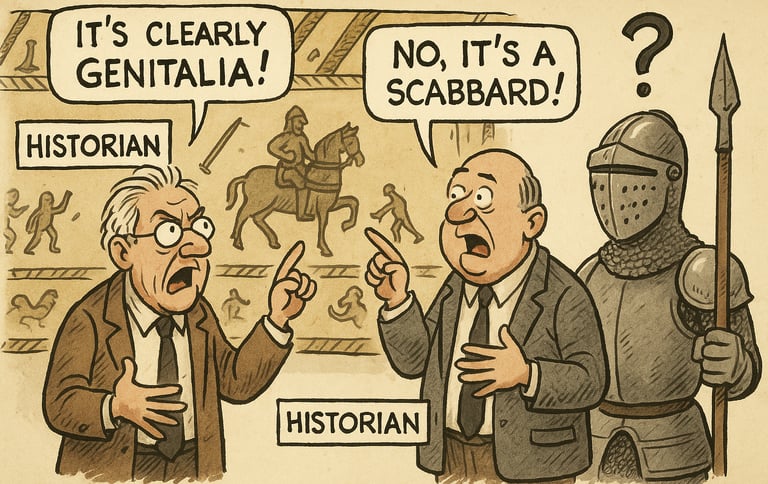Hard Facts: Why Academics Are Locked in a Feud Over the Bayeux Tapestry’s Genitalia
Historians are hilariously divided over the Bayeux Tapestry’s penis count. Here’s why one extra stitch has medievalists in a modern meltdown.
Penis Friends
8/11/20252 min read


The Stitch Heard Round the World
In the rarefied halls of academia, where people usually argue about kings, queens, and the meaning of obscure Latin phrases, a much more delicate matter has sparked a full-blown intellectual feud. Forget geopolitics, forget trade routes — today’s battleground is a nearly thousand-year-old embroidered cloth, the Bayeux Tapestry, and the issue at hand is, quite literally, at hand.
The question? Exactly how many penises are depicted on it.
At Penis Friends, we live for moments like this — when serious scholars are pulled into the kind of playground debate that would make a middle-school lunch table proud.
What Even Is the Bayeux Tapestry?
For the uninitiated, the Bayeux Tapestry is an 11th-century, 230-foot-long embroidered masterpiece chronicling the Norman conquest of England in 1066. It’s got battles, banquets, political intrigue… and, tucked in the margins, a surprising amount of male anatomy — mostly belonging to horses, but with a few human appearances thrown in for good measure.
It’s both high art and, depending on where you look, a very expensive medieval doodle sheet.
The Great Count: 93 vs. 94
Here’s where the scholarly gloves come off.
The Official Count Camp: 93 penises, mostly equine, scrupulously documented.
The Rebel Revisionists: 94, arguing there’s a missed member hiding in the margins.
The disputed image? A small, ambiguous stitch that could be a scabbard, a strap… or something far more personal. And yes, grown adults with PhDs are writing papers about this.
Patterns, Not Pranks
You’d think spotting a penis would be easy, but medieval art loves ambiguity. Scholars analyze:
Color consistency (skin tone vs. metal)
Shape repetition (weapons vs. anatomy)
Context clues (is it mid-battle or mid–barn scene?)
In other words, it’s not just “Does that look like one?” — it’s “Would a Norman stitcher intend it to be one?”
Why Medieval Genitalia Matter
Laugh if you want (we did), but these details tell us about:
Masculinity & power in medieval visual language
The role of horses as symbols of virility
Marginalia humor — bawdy little jokes to poke fun at authority
Basically, in the Middle Ages, the line between propaganda and playground humor was a single stitch wide.
Penis Friends’ Verdict: People’s Peer Review
We examined the evidence. We squinted. We tilted our heads. We even asked the office intern. Our ruling:
“Reasonable shaft, doubtfully scabbard.”
But we’ll keep it open for peer review (by which we mean memes).
Why This Feud Is Good for History
Sure, the debate is silly, but it:
Engages the public — nothing gets people into a museum like a “Guess the Genital” tour.
Highlights how close reading and material culture analysis work.
Proves that history is alive, even when it’s arguing over century-old stitches.
Threads of Truth (and the Joy of Petty Questions)
Whether the tally is 93 or 94, one thing is certain: the Bayeux Tapestry continues to delight, confuse, and, occasionally, arouse academic passion.
And here at Penis Friends, we salute the historians willing to risk their reputations to get to the bottom (and front) of history’s most stitch-perfect mystery.
FAQs
Q1: How many penises are on the Bayeux Tapestry?
Depends who you ask — 93 or 94.
Q2: Why are there so many horse penises?
Medieval symbolism + realistic anatomy = a lot of equine confidence.
Q3: Is the “extra” penis really a scabbard?
Scholars are split — literally and figuratively.
Q4: Where can I see the tapestry?
The original is in Bayeux, France. Replicas are in multiple museums worldwide.
Q5: Does Penis Friends have a stance?
Always. And ours is: if you have to ask, it probably counts.
